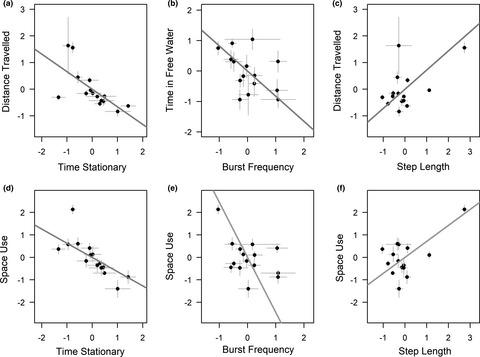当前位置:
X-MOL 学术
›
Ecol. Evol.
›
论文详情
Our official English website, www.x-mol.net, welcomes your
feedback! (Note: you will need to create a separate account there.)
“Micropersonality” traits and their implications for behavioral and movement ecology research
Ecology and Evolution ( IF 2.3 ) Pub Date : 2021-02-22 , DOI: 10.1002/ece3.7275 Joseph D Bailey 1 , Andrew J King 2 , Edward A Codling 1 , Ashley M Short 2 , Gemma I Johns 2 , Ines Fürtbauer 2
中文翻译:

“微观人格”特征及其对行为和运动生态学研究的影响
更新日期:2021-04-04
Ecology and Evolution ( IF 2.3 ) Pub Date : 2021-02-22 , DOI: 10.1002/ece3.7275 Joseph D Bailey 1 , Andrew J King 2 , Edward A Codling 1 , Ashley M Short 2 , Gemma I Johns 2 , Ines Fürtbauer 2
Affiliation

|
- Many animal personality traits have implicit movement‐based definitions and can directly or indirectly influence ecological and evolutionary processes. It has therefore been proposed that animal movement studies could benefit from acknowledging and studying consistent interindividual differences (personality), and, conversely, animal personality studies could adopt a more quantitative representation of movement patterns.
- Using high‐resolution tracking data of three‐spined stickleback fish (Gasterosteus aculeatus), we examined the repeatability of four movement parameters commonly used in the analysis of discrete time series movement data (time stationary, step length, turning angle, burst frequency) and four behavioral parameters commonly used in animal personality studies (distance travelled, space use, time in free water, and time near objects).
- Fish showed repeatable interindividual differences in both movement and behavioral parameters when observed in a simple environment with two, three, or five shelters present. Moreover, individuals that spent less time stationary, took more direct paths, and less commonly burst travelled (movement parameters), were found to travel farther, explored more of the tank, and spent more time in open water (behavioral parameters).
- Our case study indicates that the two approaches—quantifying movement and behavioral parameters—are broadly equivalent, and we suggest that movement parameters can be viewed as “micropersonality” traits that give rise to broad‐scale consistent interindividual differences in behavior. This finding has implications for both personality and movement ecology research areas. For example, the study of movement parameters may provide a robust way to analyze individual personalities in species that are difficult or impossible to study using standardized behavioral assays.
中文翻译:

“微观人格”特征及其对行为和运动生态学研究的影响
- 许多动物性格特征都有隐含的基于运动的定义,可以直接或间接影响生态和进化过程。因此,有人提出,动物运动研究可以受益于承认和研究一致的个体差异(个性),相反,动物个性研究可以采用更定量的运动模式表示。
- 利用三刺刺鱼( Gasterosteus aculeatus)的高分辨率跟踪数据,我们检查了离散时间序列运动数据分析中常用的四个运动参数(时间平稳、步长、转向角度、爆发频率)和动物性格研究中常用的四种行为参数(行进距离、空间使用、自由水中的时间和靠近物体的时间)。
- 当在有两个、三个或五个庇护所的简单环境中观察时,鱼在运动和行为参数方面表现出可重复的个体差异。此外,那些静止时间较少、采取更直接路径、较少突发旅行(运动参数)的个体,被发现会走得更远,探索更多的水箱,并在开放水域中花费更多时间(行为参数)。
- 我们的案例研究表明,量化运动和行为参数这两种方法大致相同,我们建议运动参数可以被视为“微观人格”特征,它会导致广泛一致的个体间行为差异。这一发现对人格和运动生态学研究领域都有影响。例如,运动参数的研究可以提供一种稳健的方法来分析物种的个体性格,而使用标准化的行为分析很难或不可能研究这些个体的性格。











































 京公网安备 11010802027423号
京公网安备 11010802027423号